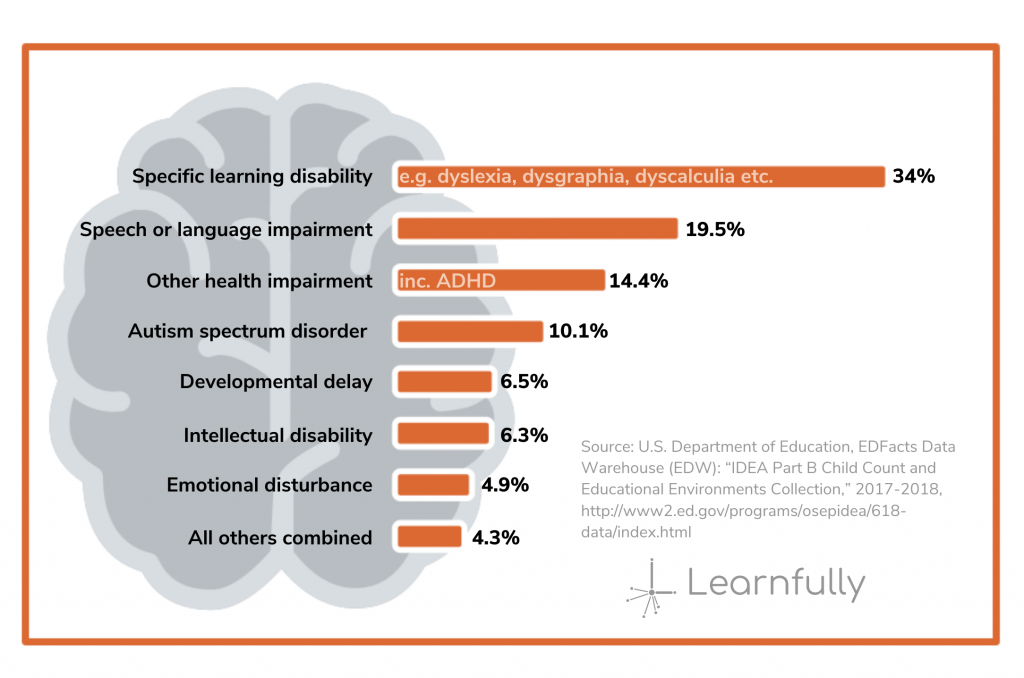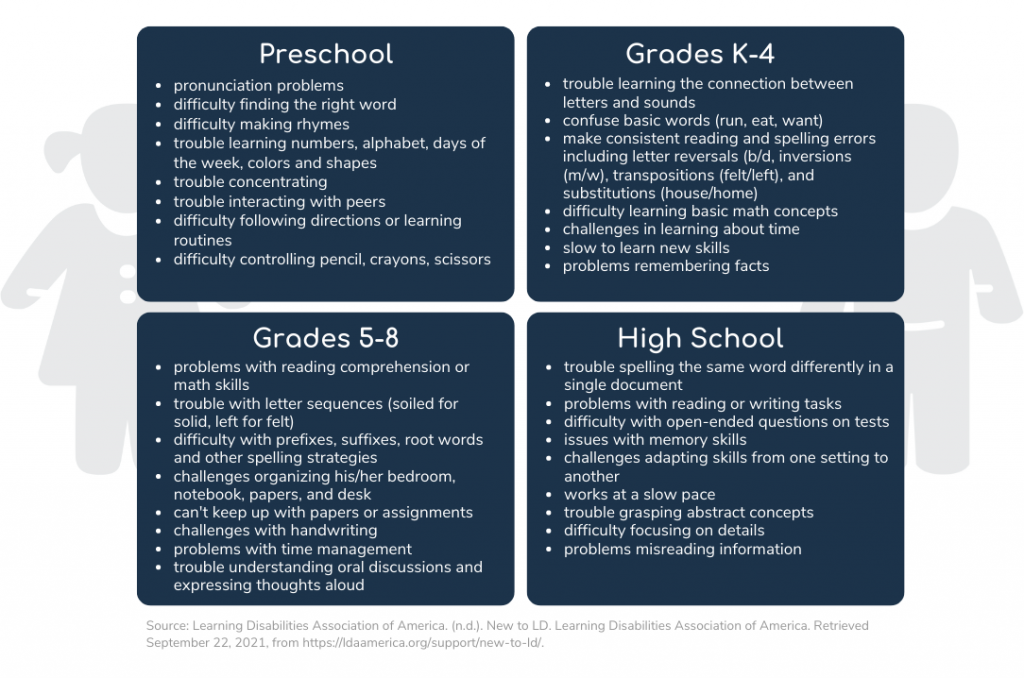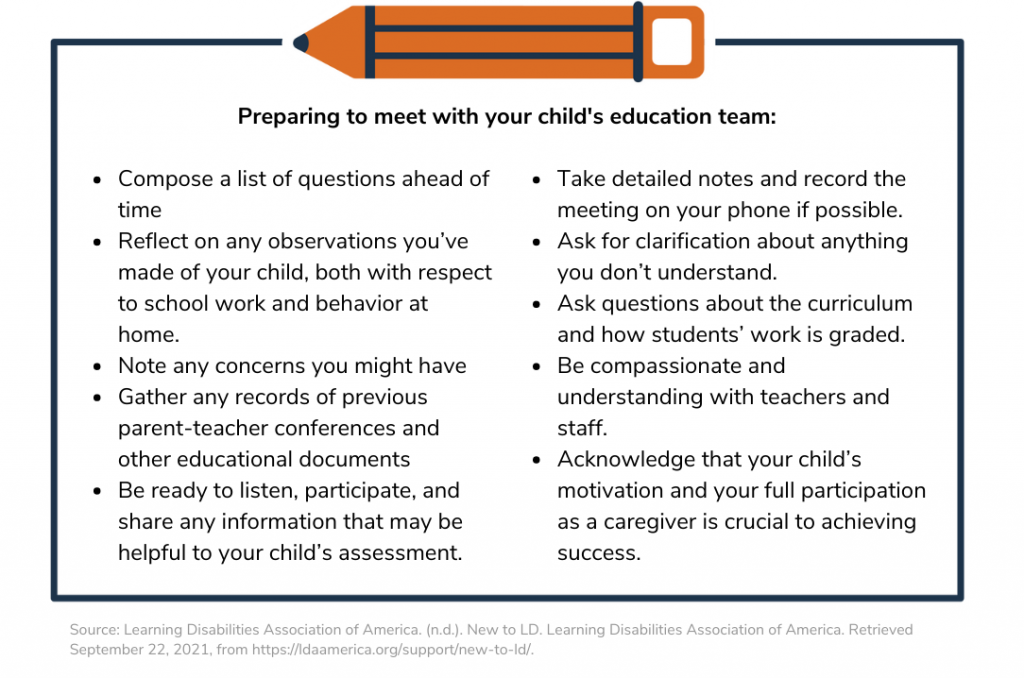This three-part series focuses on the experiences of parents and caregivers as they become aware of potential learning differences in their children and navigate the many challenges and surprises along the way.
You can find part two here: A Caregiver’s Guide to Neurodivergent Learners: Education Therapy and Other Treatment Options. Or jump to part three: A Caregiver’s Guide to Neurodivergent Learners: Finding & Measuring Success for Your Child
Embracing Neurodiversity
Seeing your child struggle can be one of the most challenging things you can go through as a parent or caregiver. The stigma and general lack of awareness surrounding neurodivergent learners can cause the problem to seem much larger than it actually is. But brain differences are totally normal, and neurodiversity shouldn’t be feared! According to a 2017 report from the National Center for Learning Disabilities, learning and attention issues are extremely common, affecting 1 in 5 children [1]. And awareness of neurodiversity in schools and families is on the rise; since the COVID-19 pandemic began, nearly three-quarters (72%) of parents have become aware that their children may have a learning difference [2].
Children with learning and attention issues are as smart as their peers and with the right support can achieve at high levels, but a lack of early or effective interventions leads too many kids on a downward spiral,” says Mimi Corcoran, President and CEO of NCLD.
Despite neural differences being normal, beginning your journey as a parent or caregiver to finding success for your child can be a stressful and confusing time. Discovering that your child may face lifelong challenges can seem overwhelming at first. But most kids with learning differences are just as smart as their peers—and many are even exceptionally talented and creative—their brains are just wired differently for learning. Neurodiverse learners (and indeed all learners) need to be taught in ways that are suited to their strengths and how they process information.
As with many things in life, the first step is often the most difficult, but getting started as early as possible is crucial to academic and life success. With the right support and services, neurodivergent learners can succeed in life and achieve their full potential. This guide will help illuminate many of the common experiences parents and other caregivers go through on the path to finding success for their learner.

Embracing individual learners’ unique neurodiversity allows us to approach growth and education in a way that appeals to their strengths and finds the optimal path to unlock their learning potential.
When you first notice a difference in your child
A learning or attention difference doesn’t typically mean a child has a lower intelligence. In fact, individuals with learning challenges usually rank average to above average on normal scores of intelligence [3]. Many times learning disabilities aren’t diagnosed until adulthood, if they are ever discovered at all. It probably comes as no surprise to parents that when a learning difference is discovered, it is often the parent who notices it first. Neurodivergent traits can manifest early in childhood as behavioral, social, emotional, or cognitive differences, or not appear until a child is school age, when they may take the form of a learning disability. When this happens, it may appear as if there is some invisible barrier that is preventing your child from reaching their full developmental or academic potential. Your learner may be exceedingly bright, yet incapable of meeting the expected skill level for someone their age.

Autism Spectrum Disorder (ASD) in children can sometimes be detected at 18 months or younger, but sometimes a final diagnosis is not received until an individual is much older, even into adulthood. The American Academy of Pediatrics (AAP) recommends screening all children for ASD at the 18 and 24-month visits. By age 2, a diagnosis by an experienced professional can be considered very reliable [4].
If left unaddressed, these differences can turn into learning gaps which cause a precipitous drop in confidence and academic performance. Thankfully, providing support and specialized instruction help close the gap, enabling success in school and life. But identifying and accepting a learning difference is the necessary first step to meeting a child’s potential.
One out of every sixteen public school students has an individual education plan (IEP) for a specific learning disability (SLD) or other health impairment (OHI), which covers ADHD [1]. 80% of children with an SLD receive special education in reading [5]. Data from the National Center for Learning Disabilities indicates that only 7% of students in special education were identified with an SLD by age 6. By age 10, this percentage had increased to 40.8%. This differs from ADHD, where nearly three-quarters of children are diagnosed by age 6 [6].

Starting the search for help for your neurodivergent learner—should you pursue an IEP?
The process of getting help for your child can seem daunting, but there are options available to learners and caregivers. The Individuals with Disabilities Education Act (IDEA) provides services and resources to help you on your journey. If your child is school age, talking with your child’s teacher is usually a good first step. Ask questions and share concerns, and build a partnership with the teacher to strategize how to support learning at home. If it is determined your child has a learning disability, IDEA states that all children in the U.S. have a right to a “free appropriate public education.” IDEA mandates the creation of an Individualized Education Program (IEP) document. Each IEP is designed to meet a child’s specific special education needs, and must be created specifically for one single student—it must be a truly individualized document. The IEP sets goals and objectives and describes what services a child will receive as part of their special education program.
Unfortunately, the IEP process can be a time-consuming, frustrating, and bewildering experience for caregivers. Receiving an IEP is a bureaucratic process, and due to the gap that exists between what the law says and the reality of school budgets and resourcing, an effective IEP can take months-to-years to get in place. Often, when a child’s neurodiversity is first discovered (or suspected) by a parent, the child’s academic struggles haven’t yet fully manifested into poor grades or other school-related issues, leading to a disparity in how the school sees your child and how you see them. These problems result in delays that waste precious intervention time.
To get started on the IEP process, a child must first be professionally evaluated for eligibility. The earliest possible intervention is vital to the child’s success in school and life, and it is critical for a caregiver to get the process started as soon as they can if a learning difference is suspected. Waiting for a child to “outgrow” a disability is ineffective, and only wastes valuable intervention time that can’t be gotten back. Worse still, a child struggling due to a learning difference may become increasingly frustrated and hopeless with school as their motivation and confidence erodes.
The IEP process won’t always catch learners at the right time. Often a learner won’t qualify for an IEP because their differences haven’t caused them to fall enough behind the expected grade-level performance to become eligible. However, their differences usually catch up to them by middle school—until then, they might have been able to effectively mask their neurodiversity and blend in with peers, but as school demands increase their delicate balancing act becomes increasingly difficult to sustain.
For parents and caregivers who don’t want to wait for the gears of the IEP process to begin to turn, Learnfully provides everything you need to immediately get your child on the path to their full potential. We will accelerate your learner’s path toward effective, evidence-based education instruction and therapy, starting with a comprehensive screener assessment, our SPARK Learning Assessment, that identifies their specific strengths and challenges. Request a sample SPARK Assessment.
Receiving a Professional Evaluation
Parents and caregivers, along with a team of qualified professionals, must determine whether a child has a disability and is in need of special education and related services. For IEPs, the child’s teacher and a professional qualified to conduct individual diagnostic examinations of children, such as a school psychologist, speech-language pathologist, or remedial reading teacher, must be included in the assessment process. The assessment must also include observations made in the child’s classroom.
Usually, your child’s teachers want to help and will work with you to try and meet your child’s learning needs. They can help arrange a comprehensive evaluation to determine how well your child is performing in school and additional services that may be necessary.
The comprehensive evaluation may not be the first step in receiving your child’s professional diagnosis. Commonly, when a child is struggling in reading or math, a school will have them take a short screening assessment to identify if they are at-risk for reading or math difficulties. The screener measures whether the student is performing at the benchmark level, a set of grade-level expectations for students’ progress of reading comprehension and related reading or math skills. If a learner tests below the benchmark level (which is about the 40th percentile nationally), the school may immediately begin to deliver intensive and individualized supplemental instruction before determining whether the student needs a comprehensive evaluation that would lead to a designation of special education eligibility [7].
Not all children who are behind grade-level benchmarks in reading or math have a learning disability, some simply need a change in how their instruction is provided. Structured, systematic instruction can help these learners catch up with their peers. This type of intervention is usually also beneficial for learners who are later diagnosed with a learning disability, so it makes sense to lead with intervention. This practice of using a systematic process for screening, intervening and monitoring is encouraged under the Individuals with Disabilities in Education Act (IDEA) and is known as Response to Intervention (RTI) [8].
Meeting with Your School and Learning Specialists
Parents and caregivers should know, however, that they don’t have to wait for some formal process of evaluation to be initiated by the school. You have the right to request a comprehensive evaluation under the IDEA law, whether or not your child is already receiving instruction under an RTI model [7]. If the IEP process is moving too slowly, isn’t working, or you just want to get a headstart on your child’s progress, you can engage Learnfully’s network of education specialists to evaluate your child and get them started with specialized, research-proven instruction and therapy.
First, you’ll want to be sure your child has had a thorough physical examination by a medical doctor to make sure that there are no underlying health problems that might interfere with learning (specifically, issues related to correctable vision and hearing-related problems). This is also one of the first things checked by specialists who evaluate children for learning disabilities (the specialists are usually experts in education, speech and language, audiology, and/or psychology). Through a series of tests, evaluations, and interviews, they work to understand what is preventing your child from achieving success in the classroom. These tests may uncover any of a number of issues, ranging from hearing or vision impairments to problems with attention, emotional management, and use of language, reading, or mathematics [9].
Diagnosing a learning disability in public schools requires several types of tests. Common tests used to diagnose a learning disability include tests of intelligence, achievement, visual-motor integration, and language tests. For instance, some commonly used achievement tests are the Wide Range Achievement Test (WRAT), Woodcock-Johnson Tests of Achievement (WJ), and the Wechsler Individual Achievement Test (WIAT). These tests are generally brief in length and designed to measure grade level proficiency in reading, writing, spelling, and math.
When preparing to meet your teacher and other specialists—including those outside of the school approval process—reflect on any observations you’ve made of your child. Include observations with respect to school work and performance, and behavior at home. Note any concerns you might have, and compose a list of questions ahead of time with the goal of gaining a better understanding of your child’s issues and how to address them in and out of school. Gather any records of previous parent-teacher conferences and other educational documents to bring with you to the meeting and share with school personnel. Be ready to listen and participate, sharing any information that may be helpful to your child’s assessment.
When the meeting happens, here are a some things to keep in mind:
- Take detailed notes and record the meeting on your phone if possible.
- Ask for clarification about anything you don’t understand. This is new to you and your child, and no one expects you to be an expert.
- To better understand and effectively track your child’s progress, ask questions about the curriculum and how students’ work is graded.
Be compassionate and understanding with teachers and staff. This is a stressful situation for you and your child, and everyone involved wants to keep enthusiasm for learning high. Acknowledge that your child’s motivation and your full participation as a caregiver is crucial to achieving success [5].

This may be the first of several meetings with your specialist team, so be sure to set up check-ins to measure progress and next steps.
Additional tests may also be used, depending on the evaluative team’s preferences and your child’s needs. The Individuals With Disabilities Education Act (IDEA) requires that a diagnosis of a learning disability is not made on the basis of a single test. Once an evaluation has been made, there are tools and techniques for managing almost any learning or behavior-related difference.
When testing for common learning disabilities, such as dyslexia, dysgraphia, or dyscalculia, an evaluation of the critical underlying skills that are closely linked to these disorders will be included in the assessment. These tests can be conducted by trained school staff or outside specialists. In dyslexia, the most common learning disability, skills tested include auditory (listening) and oral expressive language skills, phonological skills including phonemic awareness, and also automaticity and fluency (a learner’s ability to rapidly name letters and numbers) [7]. If the test detects a profile of traits consistent with those of dyslexia, an individualized education program (IEP) must be developed for the child.
Screening for autism spectrum disorder (ASD) and attention deficit hyperactivity disorder (ADHD) typically happens earlier in childhood. Most pediatricians regularly screen all children for developmental delays and disabilities (and check for markers of ASD) between 9 and 30 months. It is difficult to diagnose ADHD in children younger than 4 years, so your pediatrician will determine whether your child has ADHD using standard guidelines developed by the American Academy of Pediatrics (AAP) beginning at age 4 (and up to age 18). There is no medical test for ASD or ADHD—such as a blood test or genetic test. Early diagnosis requires a partnership between parents and pediatricians. Diagnosis of these conditions is based on monitoring and analyzing your child’s behaviors and overall development, and determining whether or not they fit criteria that characterize ASD or ADHD [10] [11].
| Learnfully provides a network of education specialists and therapists, instructional content, and evidence-based programming to help you evaluate your child and get them started with individualized learning and therapy. Contact us to get started. |
In the next part of this blog series: learn about the treatment options that are typically considered and how education therapy is a great option for many learners with differences.
[1] National Center for Learning Disabilities. (2017, February 1). The State of LD. National Center for Learning Disabilities. Retrieved September 21, 2021, from https://www.ncld.org/research/state-of-learning-disabilities/.
[2] Survey commissioned in April 2021 by Understood surveyed 1,500 U.S.-based parents of children ages 5-18 (both neurotypical children and kids who learn and think differently) about how the pandemic has impacted their education, mental health, and finances.
[3] Learning Disabilities Association of America. (n.d.). Types of Learning Disabilities. Learning Disabilities Association of America. Retrieved September 22, 2021, from https://ldaamerica.org/types-of-learning-disabilities/.
[4] National Center on Birth Defects and Developmental Disabilities, Centers for Disease Control and Prevention. (2020, March 13). Screening and diagnosis of autism spectrum disorder. Centers for Disease Control and Prevention. Retrieved September 22, 2021, from https://www.cdc.gov/ncbddd/autism/screening.html.
[5] Learning Disabilities Association of America. (n.d.). New to LD. Learning Disabilities Association of America. Retrieved September 22, 2021, from https://ldaamerica.org/support/new-to-ld/.
[6] Visser SN, Zablotsky B, Holbrook JR, et al. Diagnostic experiences of children with attention-deficit/hyperactivity disorder. National health statistics reports; no 81. Hyattsville, MD: National Center for Health Statistics. 2015.
[7] International Dyslexia Association. (2020, March 10). Dyslexia basics. International Dyslexia Association. Retrieved September 22, 2021, from https://dyslexiaida.org/dyslexia-basics/.
[8] The National Center for Learning Disabilities. (n.d.). Is RTI mandated by federal law? RTI Action Network. Retrieved September 24, 2021, from http://rtinetwork.org/component/content/article/50-what-is-rti/249-is-rti-.
[9] Learning Disabilities Association of America. (n.d.). Eligibility: Determining whether a child is eligible for special education services. Learning Disabilities Association of America. Retrieved September 22, 2021, from https://ldaamerica.org/info/eligibility-determining-whether-a-child-is-eligible-for-special-education-services/.
[10] National Center on Birth Defects and Developmental Disabilities, Centers for Disease Control and Prevention. (2020, March 13). Screening and diagnosis of autism spectrum disorder. Centers for Disease Control and Prevention. Retrieved September 22, 2021, from https://www.cdc.gov/ncbddd/autism/screening.html.
[11] American Academy of Pediatrics. (2017, January 19). Diagnosing adhd in children: Guidelines & information for parents. HealthyChildren.org. Retrieved September 22, 2021, from https://www.healthychildren.org/English/health-issues/conditions/adhd/Pages/Diagnosing-ADHD-in-Children-Guidelines-Information-for-Parents.aspx.










